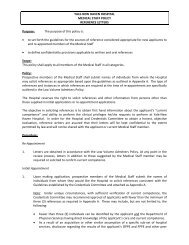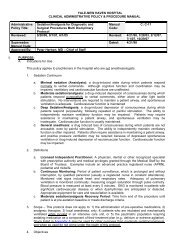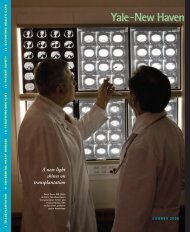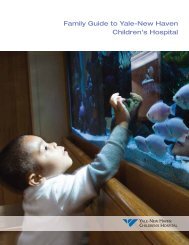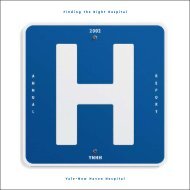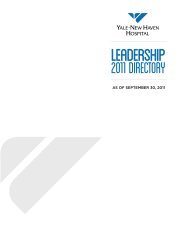Medical Staff Education Reading Materials - Yale-New Haven Hospital
Medical Staff Education Reading Materials - Yale-New Haven Hospital
Medical Staff Education Reading Materials - Yale-New Haven Hospital
You also want an ePaper? Increase the reach of your titles
YUMPU automatically turns print PDFs into web optimized ePapers that Google loves.
MEDICAL WASTE CLASSIFICATION AND SEPARATION REFERENCE CHART<br />
The following items are MEDICAL WASTE: The following items are NOT MEDICAL WASTE unless visibly dripping<br />
waste blood.<br />
1. SHARPS: to be deposited into the designated needle disposal containers. Dispose in ordinary waste containers:<br />
BLADES, GLASS SLIDES, GLASS TUBES<br />
NEEDLES- IV, HYPODERMIC, SPINAL, SUTURE<br />
LANCETS, PROBES, SAFETY PINS, SHEARS, SCRAPPERS, SCISSORS<br />
SYRINGES WITH OR WITHOUT NEEDLE, VACUTAINERS EMPTY SPECIMEN CONTAINERS<br />
GLASS MEDICATION VIALS DRESSINGS, GAUZE, 3 X 4 PADS, ETC.<br />
CHUX, SWABS, SPLINTS<br />
2. VISIBLY DRIPPING WASTE BLOOD: contain fluids where possible MASKS, GLOVES, GOWNS<br />
and deposit any items saturated with visibly dripping blood in TAPE, PADS, COTTON<br />
regulated waste container. SUTURES- without attached needle<br />
INFECTIOUS WASTE CEREBROSPINAL AND PLEURAL FLUIDS: RESPIRATORY SUCTION TUBING<br />
Void container of fluids where possible and deposit containers and/or VENTILATOR TUBING<br />
sealed units in regulated waste containers. FOLEY BAGS, FOLEY CATHETERS<br />
OR SPONGES, SUCTION TUBING & CANISTER LINERS, RED RUBBER CATHETERS<br />
OTHER SUCTION TUBING CONTAINING BLOOD, PLEUREVACS, HEMOVACS BED PANS, EMESIS BASINS<br />
BLOOD TRANSFUSION & PHERESIS FILTERS, TUBING & BAGS DIAPERS<br />
HEMODIALYSIS & CVVH FILTERS & TUBING URINALS, TOILET HATS<br />
1 LITER GLASS VACCUM BOTTLES (USED TO REMOVE ASCITES) PERI (OB) PADS<br />
SPECIMEN CONTAINERS (MOSTLY FROM LABS) SALEM SUMP (NG) TUBES<br />
IRRIGATION SETS, BULB SYRINGES<br />
3. ALL WASTE FROM BIOSAFETY LEVEL 4 AGENTS: All waste from a person PAPER TOWELS, TISSUES, CUPS<br />
with biosafety level 4 disease, such as viral hemorrhagic fever. PACKAGING MATERIALS<br />
CASTS, CAST PADDING<br />
4. CULTURES AND STOCKS of agents infectious to humans and associated PLASTIC MEDICATION VIALS<br />
biologicals including cultures from medical, clinical and hospital PERITONEAL DIALYSIS BAGS & TUBING<br />
laboratories; culture dishes and devices used to transfer, inoculate,<br />
or mix cultures<br />
5. RESEARCH ANIMAL WASTE which includes contaminated animal carcasses, Remove all needles from tubing and if the tubing is NOT visibly dripping waste blood, deposit<br />
animal bedding or animals that were intentionally exposed to<br />
infectious agents during research.<br />
tubing in ordinary waste container<br />
6. PATHOLOGICAL WASTE means any human tissue, organ or body part Empty fluid from all used/unused IV containers when possible,<br />
removed during surgery, autopsy or other medical procedure (waste to be then place in ordinary waste container.<br />
segregated in corrugated boxes).<br />
7. CHEMOTHERAPY WASTE IV bags containing less than 3% of antineoplastic Place all glass IV fluid containers into glass-only containers<br />
agents can be deposited directly into medical waste containers. Any IV If you need a glass-only container, contact Environmental Services.<br />
bag containing unused antineoplastic agents over 3% must be returned to<br />
Pharmacy for placement in special corrugated containers and disposed of<br />
as hazardous waste by incineration.<br />
Page the Nursing <strong>Education</strong> specialist or Clinical Advisor, or phone Epidemiology at 8-4634 with questions concerning medical waste classification or separation. <br />
Phone Environmental Services at 8-6688 with questions about medical waste containers or pick-up schedule. <br />
8


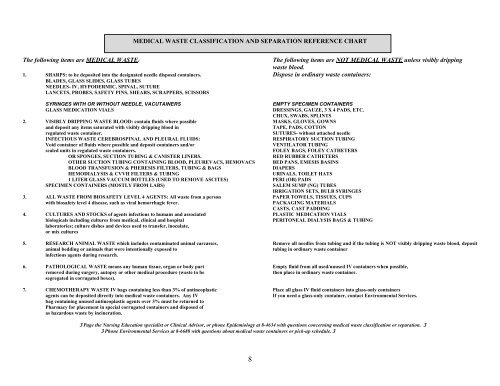



![Annual Report Donor Listings [pdf] - Yale-New Haven Hospital](https://img.yumpu.com/49673575/1/190x245/annual-report-donor-listings-pdf-yale-new-haven-hospital.jpg?quality=85)

